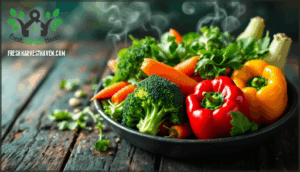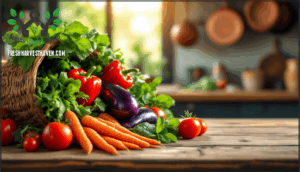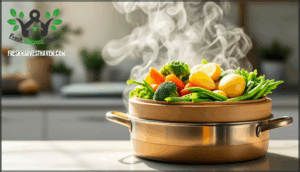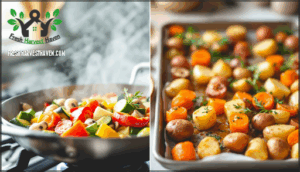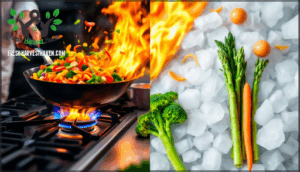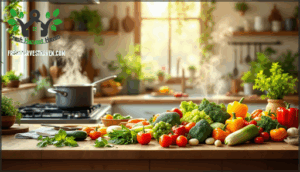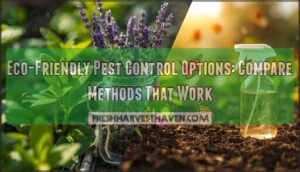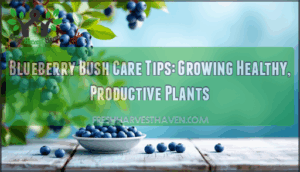This site is supported by our readers. We may earn a commission, at no cost to you, if you purchase through links.
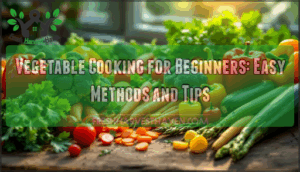
Mastering vegetable cooking for beginners doesn’t require fancy skills or expensive equipment. Once you understand how different vegetables respond to heat and moisture, you’ll stop ruining perfectly good produce. You’ll learn which methods bring out natural sweetness, which preserve vibrant colors, and how simple techniques transform raw vegetables into dishes you’ll actually want to eat.
Table Of Contents
Key Takeaways
- Understanding how different vegetables respond to heat and moisture prevents common cooking mistakes like mushy broccoli or unevenly cooked carrots, making technique more important than fancy equipment.
- Cooking methods dramatically affect nutrient retention—steaming and microwaving preserve more vitamins than boiling, while leaving skins on root vegetables boosts fiber and nutrient content.
- Proper storage extends freshness significantly by separating ethylene-producing produce from sensitive vegetables, maintaining correct humidity levels, and washing only before use rather than before storage.
- Mastering basic techniques like roasting for caramelization, sautéing for quick browning, and blanching for bright colors gives you the foundation to cook any vegetable confidently without memorizing recipes.
Essential Vegetable Types for Beginners
When you’re starting your cooking journey, knowing which vegetables to work with makes all the difference. Different types have different textures, flavors, and cooking times, so understanding the basics helps you choose the right ones for any dish.
Let’s break down the main vegetable categories you’ll encounter most often in your kitchen.
Root, Leafy, and Stem Vegetables
When you’re just getting started in the kitchen, root vegetables, leafy greens, and stem vegetables are your trusty trio—they’re forgiving, adaptable, and practically beg to be cooked. Here’s what makes each group special:
- Root vegetables like carrots, potatoes, and beets grow underground and deliver hearty root nutrition that holds up beautifully when roasted or boiled.
- Leafy greens such as spinach and kale offer tender leafy varieties packed with vitamins—perfect for quick sautés or fresh salads.
- Stem vegetables like asparagus and celery need minimal stem prep and add satisfying crunch to any dish.
Master these basics, and you’ll discover countless vegetable recipes while building confidence with different cooking methods and storage tips.
Cruciferous and Allium Vegetables
Once you’ve got those three categories down, it’s time to meet two powerhouse families that’ll seriously upgrade your cooking: cruciferous vegetables like broccoli and cauliflower, and allium vegetables like onions and garlic. Both bring unique flavor profiles and serious health perks to your vegetable recipes.
| Vegetable Family | Why They’re Wonderful |
|---|---|
| Cruciferous Vegetables (broccoli, cauliflower) | Packed with sulfur compounds that support cancer prevention and add nutty depth when roasted |
| Allium Vegetables (onions, garlic) | Rich in allium compounds that create savory bases and boost nutrient synergy in dishes |
| Best Cooking Methods | Roasting brings out sweetness; sautéing builds bold flavor for vegetable recipes and ideas |
Cooking with vegetables from these families transforms simple meals into something special.
Fruit and Podded Vegetables
If you thought onions and garlic were game-changers, wait until you start working with fruit vegetables like tomatoes and cucumbers, plus podded varieties such as peas and beans. These two groups open up endless vegetable recipes and ideas.
Fruit vegetables bring juicy sweetness and fresh culinary uses to salads and sauces, while podded vegetables deliver protein-packed nutrition.
Cooking with vegetables from both categories means you’ll master fruit pairings, understand podded storage basics, and discover why cooking fruits alongside podded varieties creates balanced, satisfying meals.
Seasonal and Color-Based Varieties
When you start picking vegetables by season and color, you’re not just shopping smarter—you’re unlocking better flavor, fresher produce, and a rainbow of nutrients on every plate. Seasonal availability means vegetables are at their peak ripeness, while color nutrients vary—purple vegetables like eggplant, red tomatoes, and green beans each offer different health benefits.
Variety selection by season and hue transforms cooking impacts and helps you explore regional specialties that shine in local markets.
Nutritional Benefits of Cooking Vegetables
When you cook vegetables, you’re not just making dinner—you’re unlocking a powerhouse of nutrition that keeps your body running strong. The vitamins, minerals, and fiber packed into these plant foods do everything from sharpening your energy to protecting your long-term health.
Let’s break down exactly what you’re getting when you add more vegetables to your plate.
Key Vitamins and Minerals
Vegetables pack vitamins A and C into every bite—carrots deliver 1,070 micrograms of vitamin A per cup, while red peppers soar to 191 mg of vitamin C. You’ll also get essential minerals like potassium and iron, though mineral variation means potatoes offer 888 mg of potassium compared to corn’s 392 mg.
Cooking impact matters: microwaving preserves vitamin retention better than boiling. Organic nutrients often shine brighter—organic spinach contains 52% more vitamin C than conventional. Understanding mineral bioavailability helps you get the most out of the nutritional benefits of vegetables for real health benefits.
Vegetables can also improve digestive health due to their high dietary fiber content.
Fiber and Digestive Health
Your gut thrives on the dietary fiber found in vegetables, which directly improves gastrointestinal health and aids daily bowel function. Here’s how fiber intake and health connect:
- Daily intake goals: Women need 25 g, men need 38 g (most adults only get 16 g)
- Fiber types work differently: Soluble fiber (carrots, squash) regulates blood sugar; insoluble fiber (burdock) adds stool bulk
- Gut microbiota flourishes: Just 5–8 g of fermentable fiber boosts beneficial bacteria like bifidobacteria
- Bowel health improves: Fiber prevents constipation, hemorrhoids, and diverticulitis while speeding gut transit
- Cooking effects matter: Steaming preserves fiber better than boiling, which leaches nutrients into water
Including more fiber may also reduce the risk of cardiovascular disease (CVD).
Disease Prevention and Wellness
Eating a rainbow of vegetables builds powerful defenses against chronic disease. You’ll slash your heart disease and stroke risk by roughly 20% when you eat more than five servings daily—green leafy and cruciferous varieties deliver the strongest protection.
Eating five daily servings of colorful vegetables—especially leafy greens and cruciferous types—cuts heart disease and stroke risk by roughly 20%
Cancer prevention, particularly for esophageal cancer, improves with regular vegetable intake, and compounds like sulforaphane in broccoli offer neuroprotective benefits.
Your mental wellness gets a boost too, as raw vegetables reduce depressive symptoms while supporting immune function through vitamin C and beta carotene.
Blood pressure drops naturally when you load your plate with these plant-based foods.
Choosing and Storing Fresh Vegetables
Getting great results in the kitchen starts with picking the right vegetables and keeping them fresh until you’re ready to cook. You’ll save money and reduce waste when you know what to look for at the store and how to store each type properly.
Let’s walk through the essentials that’ll help you become confident with fresh produce.
How to Select Quality Produce
Picking the right vegetables at the store isn’t about luck—it’s about knowing what to look for with your eyes, nose, and hands. Start with a visual inspection: fresh vegetables should have bright, vibrant colors without bruises or soft spots. Do a quick firmness test by gently squeezing—quality produce feels solid, not mushy.
Give them an aroma check too, especially seasonal vegetables like tomatoes or cucumbers. When possible, choose organic certification options for vegetables for culinary use, and always shop seasonal availability to get the freshest picks.
Proper Storage Methods
You’ve brought home beautiful vegetables—now let’s make sure they stay that way instead of turning into sad, wilted science experiments in your crisper drawer. Understanding vegetable storage and preservation methods makes all the difference:
- Leafy greens: Store in high humidity control settings, wrapped loosely in damp paper towels
- Root vegetables: Keep in cool temperature ranges around 32-40°F, away from ethylene gas producers
- Tomatoes and peppers: Use breathable container types at room temperature for best flavor
- Cruciferous vegetables: Refrigerate unwashed in perforated bags to extend shelf life
- Fresh vegetables: Separate ethylene-producing items (like apples) from sensitive produce
Proper vegetable harvesting and storage techniques preserve quality for days longer.
Tips for Reducing Spoilage
Even in the best-kept kitchens, vegetables can go from crisp to compost faster than you’d expect—but a few smart habits can help you stretch their shelf life and save money.
Check storage temperature regularly, adjust humidity control in your crisper, and keep ethylene gas producers separate from sensitive veggies.
Practice proper washing only before use—not before storage—and use rotation methods to eat older fresh vegetables first. These vegetable preservation methods protect your produce investment.
Simple Vegetable Cooking Methods
Learning to cook vegetables doesn’t have to feel overwhelming. Once you understand a few basic methods, you’ll be able to prepare almost any vegetable with confidence.
Let’s walk through the most beginner-friendly techniques that’ll become your go-to approaches in the kitchen.
Steaming and Boiling Basics
Steaming and boiling are two of the gentlest ways to cook vegetables, preserving their natural color and nutrients while keeping things simple. Here’s how to get started with your cooking utensils and healthy eating journey:
Key tips for steaming and boiling vegetables:
- Use just enough water level to create steam without drowning your vegetables
- Check steaming times for different types of vegetables—tender greens need 3-5 minutes, while root vegetables take longer
- Keep lids on to trap heat and speed up cooking
- Add herbs or garlic for flavor infusion while protecting nutrient content
Both methods lock in what makes your vegetable guide favorites so nutritious while keeping prep easy.
Sautéing and Roasting Techniques
When you’re ready to turn up the heat and add deeper flavor, sautéing and roasting are your go-to techniques for bringing out the natural sweetness and richness hidden in vegetables.
For sautéing, grab a wide pan and heat your oil selection—olive or avocado work great—over medium-high heat. Toss in your vegetables and keep them moving for even browning.
Roasting takes longer but rewards you with caramelized edges. Spread your vegetables on a sheet pan, coat with roasting seasonings, and bake at 400-425°F. Test doneness by piercing with a fork—tender inside, golden outside means you’ve nailed it.
Blanching and Stir-Frying Tips
If you want vegetables that stay bright and crisp or need a lightning-fast cooking method for busy weeknights, blanching and stir-frying will become your secret weapons. Blanching times are quick—30 seconds to 2 minutes in boiling water, then straight into ice water.
For stir-fry, heat control matters. Use high heat with the right oil selection and add vegetables in stir-fry order: dense types first, delicate ones last. Master sauce techniques to finish strong.
Easy Vegetable Recipes and Meal Ideas
Now that you know how to cook vegetables, it’s time to put those skills to work.
Let’s look at some simple recipes that’ll help you build confidence in the kitchen. These ideas range from easy side dishes to complete meals that showcase your newfound vegetable-cooking abilities.
Quick Sides and Salads
Sides and salads don’t have to be an afterthought—they’re your secret weapon for turning any meal into something colorful, crunchy, and downright crave-worthy.
Start with a vegetable guide that includes different types of vegetables: leafy vegetables like spinach, raw veggies like bell peppers, and leftover veggies from yesterday’s roast.
Simple dressings—olive oil, lemon, and salt—bring salads to life. Try quick pickles with cucumbers or salad prep tricks like washing greens ahead of time.
Beginner-Friendly Main Dishes
Vegetables aren’t just for side dishes—they can be the star of your plate, and beginner-friendly main dishes prove that cooking with them is easier (and tastier) than you might think. Simple stir-fries pack vegetables into quick soups or veggie pasta.
One-pan roasts and easy casseroles make healthy eating and nutrition simple. Follow your vegetable guide to build plant-based diet dishes that satisfy.
Creative Ways to Add More Vegetables
You might be surprised how sneaky—and downright fun—it is to pack more vegetables into meals you already love. Try sneaky veggies like grated zucchini in muffins or hidden purees stirred into sauces.
Vegetable swaps—cauliflower rice or zoodles—boost nutrition facts without losing flavor.
Experiment with flavor pairings and creative garnishes to make healthy eating exciting and delicious every single day.
Frequently Asked Questions (FAQs)
How do I prevent vegetables from sticking?
Proper Pan Selection and Heat Control make all the difference. Use enough oil to coat the bottom, preheat your pan, and don’t overcrowd.
Moisture Content matters too—pat vegetables dry before cooking and stir regularly for even browning.
What equipment do beginners really need?
A sharp knife, cutting board, and basic saucepan cover most prep and cooking needs.
Add storage containers for leftovers and a few prep bowls to simplify your workflow when building healthy meals with fresh vegetables.
How can I make vegetables taste better?
Think of flavoring vegetables like dressing up a plain canvas—seasoning techniques and smart flavor pairings transform everything.
Roasting caramelizes natural sugars, while garlic, herbs, olive oil, and a pinch of salt boost taste instantly, making healthy eating genuinely enjoyable.
Should I peel vegetables before cooking them?
Peeling depends on the vegetable type and your priorities. Leaving skins on root vegetables like carrots boosts nutrient retention and adds fiber, but scrub them well to reduce pesticide exposure.
Remove tough or bitter skins that affect cooking time or texture, preserving health benefits.
How do I know when vegetables are done?
Most vegetables reach perfect doneness when they’re tender yet crisp. Use visual cues like vibrant color and texture indicators—a fork should pierce easily but not turn mushy.
Testing methods vary by type, so check cooking times and doneness temperatures for best results.
Conclusion
You’ve learned how to choose fresh vegetables, store them properly, and cook them using methods that actually work. You’ve discovered why timing matters, how heat transforms texture, and which techniques bring out natural flavors.
Vegetable cooking for beginners isn’t about memorizing recipes—it’s about understanding what happens when heat meets produce. Start with one method that interests you. Practice it until vegetables stop ending up as mush or charcoal. Then move to the next technique. Your confidence will grow with each properly cooked batch.
- https://www.merriam-webster.com/dictionary/composition
- https://fdc.nal.usda.gov/
- https://www.mdpi.com/2077-0472/9/3/47
- https://www.hsph.harvard.edu/news/press-releases/higher-dietary-fiber-intake-in-young-women-may-reduce-breast-cancer-risk/
- http://journals.plos.org/plosmedicine/article?id=10.1371/journal.pmed.1001878

